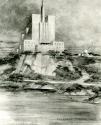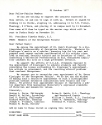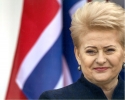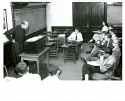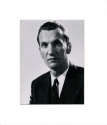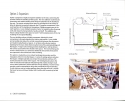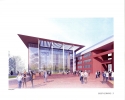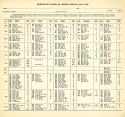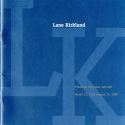At the conclusion of World War One, the United States emerged as a leading nation in trade, international politics, and military power. The need for a school to train young people in global commerce, international diplomacy, and global affairs was apparent.
That school was founded at Georgetown as the School of Foreign Service in 1919, five years before the United States Foreign Service was created, with a mission marrying international affairs to Jesuit values of service. Initially placed in the hands of Father Edmund A. Walsh, the school educated many generations of leaders who would dominate their fields through the next century—contributing not only in diplomacy and business but also in culture, security, international development and other fields.
This exhibition traces the history of the Walsh School of Foreign Service, upon its centennial, through the stories of its architects, professors, students, and alumni.
Founding and Founder
In 1919, a well-traveled 34-year-old Jesuit priest, Fr. Edmund Walsh, helped Georgetown found a new school. Walsh imagined the School of Foreign Service, the first school of its kind in the United States, would educate students from a global perspective and advance the cause of peace. Today, the values that drive the SFS can be traced to its founding—and its founder.
Six Months That Changed the World
Book: Paris 1919: Six Months That Changed the World, by Margaret MacMillan
Photo: David Lloyd George and President Woodrow Wilson at Versailles, 1919
Pamphlet: Program from the Inaugural Lloyd George Lecture, 2018
(School of Foreign Service)
In the aftermath of World War I, the events of 1919 set the stage for a new era in world affairs. The war had decimated the old world order, dominated by empires and conflict — and world leaders saw an opportunity to shape a new order based on cooperation and peace.
This book about the Versailles Conference of that year, which aspired to lay the groundwork for a lasting global peace, was the subject of the first installment in the Lloyd George lecture series to celebrate the SFS centennial. History professor Margaret MacMillan said that period of six months in 1919, which also saw the founding of the SFS, was an “extraordinary event” filled with “tremendous hopes for revenge, justice, recompense, a new world.”
Draft Letter on the Establishment of the Georgetown University School of Foreign Service
Draft Letter on the Establishment of the Georgetown University School of Foreign Service
(Georgetown University Archives)
While world leaders gathered in Paris, Fr. Edmund Walsh pursued the same vision of an interconnected world on the Hilltop as he built the School of Foreign Service.
This unsigned draft of a circular communication issued a call to potential benefactors for the new school. Georgetown, it said, would be the home of the first program in the country to train diplomats and world traders.
Fr. Walsh set out to convince potential benefactors that the school would answer the urgent need to prepare for a new era of peace and interconnectedness in the wake of World War I. This draft debuted a new phrase to explain the need for the SFS: “America, unprepared for war, is determined not to be unprepared for peace.”
Constantine McGuire, the "Man of Mystery" Behind the Founding of the SFS
Courier, December 1965
(Georgetown University Archives)
Fr. Walsh is widely recognized as the founder of the SFS, but even he had insisted that others deserve more of the credit. Walsh was given the task of founding the school by University President John Creeden — and it was Constantine McGuire, an eccentric and obsessively private economist, who first persuaded Creeden to take it on.
According to this obituary in the SFS Courier, McGuire said in April 1953 that he had drawn up plans for the school in 1916 or 1917. The proposal was passed through a friend to University President John Creeden, who approved it and called on Fr. Walsh to create it.
McGuire continued to play an instrumental role in the early stages. He helped obtain donations and hire faculty. McGuire had an influence on Walsh, whom he held in great respect. For years, McGuire would send Walsh advice on details of the School’s operations.
Enlisted Students Conduct Drills on Campus During World War I, 1918
(Georgetown University Archives)
Georgetown students who enlisted to serve in the war used the old Ryan Gymnasium and the athletic fields on the front lawn to conduct their drills. In June 1919, the same year the SFS was founded, the Georgetown senior class planted poplar trees on campus to honor the 53 alumni killed in battle.
For Fr. Walsh, the violence of the war demonstrated the need for institutions such as the SFS to educate diplomats, businessmen and others in the fundamentals of international cooperation and understanding.
Founding Donor James A. Farrell at the Philadelphia Trade Convention, 1922
(Georgetown University Archives)
The first recorded donation to the School came from James A. Farrell, the president of U.S. Steel. Under his leadership, the company grew into the world’s first billion-dollar business.
The magnate also recognized the need for globally conscious men in an era of international trade. This photograph shows Farrell (front row, second from left) seated with Fr. W. Coleman Nevils (center), then the dean of Georgetown College.
Walsh’s Peace Bulletin No. 2, 1919
(Georgetown University Archives)
In the school’s early years, a series of “Peace Bulletins” were published under Fr. Walsh’s title as the school’s regent regarding current events and academic matters.
This pamphlet, the second such bulletin, includes a collection of recent statements from high-ranking government officials declaring a pressing need for men well-educated in foreign affairs. Among the officials cited are the acting secretary of the Department of Commerce, the director general of the Pan American Union and the head of consular services for the State Department.
Speeches from the Formal Commemoration of the Founding of the School of Foreign Service, November 25, 1919
(Georgetown University Archives)
Diplomats, members of Congress and Cabinet secretaries ducked out of the rain into regal Gaston Hall on the evening of November 25, 1919, to formally celebrate the founding of the nation’s first School of Foreign Service.
“No ordinary motive could have served to gather under inclement skies an assemblage of such varied nature,” Walsh said in his opening address. A series of speeches by Georgetown faculty and distinguished guests highlighted the grand hopes for the newborn school.
Program from Dinner for the First Graduating Class, 1921
(Georgetown University Archives)
The first class of students of the new School of Foreign Service graduated in 1921. The cohort celebrated the landmark event with a dinner at the grand Raleigh Hotel, a Beaux Arts high-rise on the corner of 12th Street and Pennsylvania Avenue.
This program for the event features a drawing of a ship, a trademark widely used in the school’s early years.
Proposed Sketches for the School of Foreign Service Building by Murphy & Locraft
(Georgetown University Archives)
These proposals for a new home for the School were commissioned by Fr. Walsh. The first, almost ludicrously ambitious proposal reflected the heights of Walsh’s ambitions with a towering modern cathedral of foreign service. A later sketch comes somewhat closer to the scale of the actual building, named for Walsh, where the School ultimately moved in 1958.
Photographs of Fr. Walsh on His Humanitarian Mission to Russia, 1922
(Georgetown University Archives)
Shortly after founding the School, Fr. Walsh left it behind to lead the Papal Relief Mission to Russia in 1922. Pope Pius XI ordered the mission and charged Walsh with helping to alleviate famine in the Soviet-led state. The conditions Walsh observed in Russia — particularly the repression of Christianity under the Communist regime — helped spark the fierce anti-Communist convictions that drove his academic career.
Fr. Walsh’s Passports
(Edmund A. Walsh, S.J. papers, Booth Family Center for Special Collections)
Fr. Walsh’s work in Russia and his founding of the School bolstered his reputation as one of the world’s preeminent diplomats. The anti-famine assignment in Russia would be the first of many international relief and diplomatic missions over the next several decades. Walsh’s passports quickly overflowed with stamps from the United Kingdom, France, the Middle East and more.
Fr. Walsh Observes Destruction at Nuremberg
(Edmund A. Walsh, S.J. papers, Booth Family Center for Special Collections)
After the Second World War, Fr. Walsh was called to Nuremberg to aid the prosecution of alleged Nazi war criminals after World War II, one of the first steps towards rebuilding Europe. Walsh was tasked with assessing evidence for a case against a German professor whose theories of geopolitics were used to justify Nazi actions. In this photograph, Fr. Walsh walks through the rubble remains of a Nuremberg city block.
Fr. Walsh Notebooks from the Nuremberg Trials
(Edmund A. Walsh, S.J. papers, Booth Family Center for Special Collections)
Fr. Walsh took diligent notes related to the proceedings he participated in at Nuremberg in these three notebooks. His notes are handwritten, and the cover of each volume bears his distinctive signature.
Walsh in Tokyo with General Douglas MacArthur
(Edmund A. Walsh, S.J. papers, Booth Family Center for Special Collections)
By the end of World War II, Fr. Walsh had established himself as a virtually ubiquitous figure in world affairs. After the war, he was not only summoned to support the Nuremberg trials, but also flew to Japan in 1947 to meet with General Douglas MacArthur, the American general leading the postwar Allied effort to transform and rebuild a defeated Japan. Walsh and MacArthur are pictured here striding out of the headquarters of the Allied occupation in Tokyo.
Fr. Walsh Lecture Series Cards
(Georgetown University Archives)
Fr. Walsh remained an active presence in the SFS for decades after its founding. Cards like these served as invitations to attend Walsh’s influential series of evening lectures in Gaston Hall on topics related to communism and the Soviet Union.
These cards advertise lectures on topics including Joseph Stalin, Leon Trotsky, and the state of religion in Soviet Russia, among others.
Walsh Medals
(Georgetown University Archives)
Fr. Walsh’s work around the world over decades earned him the appreciation of an array of world governments. As such, he gathered an impressive collection of medals recognizing his service.
The medal on the left is the Star of the Serbian Order of St. Sava, which the Kingdom of Yugoslavia awarded Fr. Walsh in 1937. On the left is the White Rose of Finland, the highest civilian distinction the Finnish government can bestow, given to Walsh in 1941 for his work on famine relief.
Walsh's Swagger Stick
(Georgetown University Art Collection)
Fr. Walsh was an avid traveler and known to return with tokens from abroad. This handmade weapon contains a retractable metal spike. A swagger stick was often carried by uniformed military personnel as a symbol of authority. It was found among Father Walsh's effects. This stick is probably Asian and from the early 20th century. It is made of rattan, leather and metal.
Walsh's Opium Pipe
(Georgetown University Art Collection)
According to the handwritten note that accompanied this unusual piece, it was sent from Hong Kong to Fr. Walsh at some point in time and transferred to Special Collections in 1959. The Chinese item, dating from the turn of the 20th century, includes an engraved illustration, decorative tassel and brass plating.
Diplomacy and Nation Security
An interconnected world demands strong diplomatic ties among nations, and a strong defense. Nothing proved this more than the two World Wars which, in the early years of the SFS, left a wake of destruction around the world. In response, the SFS has established programs over decades to train a strong corps of diplomats and protect nations from conflict.
Announcement of the Institute of World Polity, 1944
(Georgetown University Archives)
The 25th anniversary of the founding of the School in 1944 came under demoralizing circumstances: For the second time that century, the world was at war with itself.
Fr. Walsh saw that the need for education in diplomacy was even greater than it had been at the start, and again prepared his School to rebuild after the war. In 1944, he announced the launch of the Institute of World Polity — a specialist program of studies “dealing with the political, economic, social, legal, ethical and financial problems of reconstruction” after World War II.
Willard Beaulac, Pioneer Student of the School of Foreign Service, 1921
Yearbook Photo, 1921
Book: Beaulac’s Essay in “On the Hilltop”, 1966
Beaulac’s Remarks at Fr. Walsh Jubilee Celebration
(Georgetown University Archives)
Willard Beaulac, or “Bo” to his friends, left the Navy in 1919 to earn his place in history as a member of the School’s first class of graduates in 1921. After graduating, Beaulac joined the U.S. Foreign Service. He went on to serve as the U.S. ambassador to Paraguay, Colombia, Cuba, Chile and Argentina.
At Georgetown, Beaulac said in a 1952 speech honoring Fr. Walsh, he learned not only the technical skills of diplomacy, but also the values of “tolerance and understanding.”
Bo was not the only distinguished graduate of the School’s first class: He studied alongside Richard Butrick, who later served as director general of the Foreign Service, and Walter J. Donnelly, who served as ambassador to Costa Rica, Venezuela, Austria and Germany.
Melissa Foelsch Wells
Yearbook Photo, 1956
Honorary Degree Citation, 1991
(Georgetown University Archives)
Melissa Foelsch’s page in the SFS yearbook of 1956 is a sea of male faces — all except her own. Wells was among the first female students to graduate from the SFS.
Melissa Foelsch Wells, her name since marriage, later served as the U.S. ambassador to five countries: Cape Verde, Guinea-Bissau, Mozambique, the Democratic Republic of the Congo, and Estonia. Her honorary degree citation from Georgetown in 1991 noted her success supporting crucial humanitarian reforms using her post in Mozambique.
Cora Lijek, Mark Lijek and Bob Anders, U.S. Diplomats Rescued from Iran
Yearbook Photos for Robert G. Anders and Cora Lijek
Article: Headline in The Hoya About Alumni Escaping Iran
(Georgetown University Archives)
The Canadian Caper may have been one of the most daring and bizarre episodes of the Iran hostage crisis. In 1979, CIA rescuers plotted to extract six U.S. embassy officials from Tehran using a theatrical cover story: They entered the country as film executives scouting locations for a fake sci-fi flick.
The incident became world-famous decades later, after the 2012 film Argo portrayed events in fictionalized form.
Georgetown’s connection to the international incident is less well-known: Three of the Americans rescued from Iran were SFS alumni — including Cora and Mark Lijek, a couple on their first foreign service post who later featured on Argo movie posters.
Dean Peter Krogh with Three U.N. Ambassadors
(Georgetown University Archives)
Former SFS Dean Peter Krogh (left) is captured here alongside three distinguished members of the SFS community, all of them former U.S. ambassadors to the United Nations: Madeleine Albright, Don McHenry and Jeane Kirkpatrick.
Jeffrey DeLaurentis, U.S. Ambassador to Cuba
Yearbook Photo
Photo: DeLaurentis at Event Celebrating U.S. Opening to Cuba, 2016
(Georgetown University Archives / School of Foreign Service)
When former President Barack Obama restored diplomatic relations with Cuba, ending a half-century-long freeze, he tapped Jeffrey DeLaurentis to be his man in Havana.
A 1976 graduate of the SFS, DeLaurentis became the first American ambassador to Cuba since the beginning of the diplomatic freeze in 1961. After nominating him to the post, Obama said in a statement that "Jeff's leadership has been vital throughout the normalization of relations between the United States and Cuba,” and called the appointment a “common-sense step forward toward a more normal and productive relationship between our two countries.”
In 2017, DeLaurentis returned to the SFS as a distinguished resident fellow at the Institute for the Study of Diplomacy.
Paula Dobriansky, Distinguished U.S. Diplomat and White House Official
Hoya Review
(Georgetown University Archives)
“Georgetown opened the door for me to all that Washington has to offer,” Amb. Paula Dobriansky (SFS’77) told a magazine profile-writer in 1985 while serving as the National Security Council’s director of European and Soviet affairs under President Ronald Reagan. Dobriansky credited her SFS education for opening doors to her early in her career, ultimately supporting her meteoric rise to the White House staff.
Dobriansky later held foreign policy and diplomatic posts under several administrations and is now a senior fellow at Harvard University’s Belfer Center for Science and International Affairs.
Amb. Todd Robinson, Senior U.S. Diplomat in Latin America
Yearbook Photo
(Georgetown University Archives)
A 1985 graduate of the SFS with a bachelor’s degree in human and international affairs, Ambassador Todd Robinson has served in a number of prominent U.S. diplomatic missions, including posts in Guatemala, the Dominican Republic and Colombia. Most recently, Robinson served five months as Charge d’Affaires in Caracas, Venezuela, before he was expelled by Nicolas Maduro amid escalating tensions with the United States. Robinson now works in Washington, D.C., as the State Department’s senior adviser on Central America.
Taro Kono, Japanese Minister of Foreign Affairs
Yearbook Photo
(Georgetown University Archives)
Born and raised in Japan by a family of politicians, Taro Kono matriculated to the SFS after deciding to attend college in the United States. Years after earning his bachelor’s degree in international politics in 1986, Kono returned to Japan to run for the House of Representatives. Considered a “maverick” on domestic political issues, Kono has cultivated relations with Washington since 2017 as minister of foreign affairs.
The Hoya Battalion Prepares for War
(Georgetown University Archives)
As the nation made preparations to enter World War II, Georgetown’s Reserve Officer Training Corps answered the call to service. An urgent nationwide need for officers meant the Hoya Battalion were quickly commissioned, and university courses were suspended to convert Georgetown’s campus into Army specialized training grounds. In all, 171 Georgetown soldiers lost their lives in the war.
September 12, 2001, Day of Dialogue
(Georgetown University Archives)
On September 12, 2001, the city and the nation were stunned and bereaved after the terrorist attacks on the Pentagon and the World Trade Center. SFS faculty members mobilized in the aftermath of the attacks to help the Georgetown community understand what had happened and what would come next.
Georgetown College and SFS professors held discussions in the Intercultural Center Auditorium and Gaston Hall throughout the afternoon and night, helping students find the words to explain the traumatic events.
Henry Kissinger Joins the School, Sparking Anger and Backlash
Report on Kissinger’s Appointment
Article in The Hoya Covering Kissinger Backlash
SFS Faculty Letter Opposing Kissinger’s Appointment
(Georgetown University Archives)
Fresh off a highly controversial term as Secretary of State to President Richard Nixon, Henry Kissinger accepted a position as a visiting professor at the School of Foreign Service. The high-profile appointment received a frosty welcome on the Hilltop. A group of students, joined by some faculty, protested the decision as a “public departure from Georgetown University’s expressed standards of Christian and humanistic values.”
Jeane Kirkpatrick, First Female U.S. Ambassador to the United Nations
Photo: Jeane Kirkpatrick with University President Timothy Healy, S.J.
1981 Record Article About Kirkpatrick’s Work
Obituary in Georgetown Magazine
(Georgetown University Archives)
Jeane Kirkpatrick was nothing if not a pioneer.
After joining Georgetown’s faculty in 1967, Kirkpatrick’s neoconservative policy stances captured the attention of then-presidential candidate Ronald Reagan. Kirkpatrick became an adviser to Reagan, and later, his pick to represent the United States to the United Nations.
Kirkpatrick was the first American woman to serve in that post and the first woman from any country to serve on the U.N. Security Council.
She returned to Georgetown after her government career, ultimately teaching for more than 40 years. Kirkpatrick died in December 2006.
President Bill Clinton’s Student Government Races
(Georgetown University Archives)
An instantly recognizable Bill Clinton (SFS ’68) graces the cover of this pamphlet for the young Clinton’s campaign for president of East Campus Student Council.
Though he was a rising star in student government since his first successful campaign in freshman year, Clinton came up short in this bid for student body president. Clinton’s electoral history after college was equally scattered with wins and losses, until his determination guided him to the White House in 1992.
King Felipe VI of Spain
(Georgetown University Archives)
Spain’s current king, Felipe VI, ascended to the throne after his father’s abdication in 2014. Felipe attended the SFS for his post-graduate education, earning his degree in 1995. Felipe has stayed involved in the SFS community since his graduation, including finding occasion to stop by his alma mater while visiting Washington, D.C. Felipe visited most recently in 2015 with his wife, Queen Letizia.
King Abdullah II of Jordan
(School of Foreign Service)
Abdullah II bin Al-Hussein, the king of Jordan since 1999, earned a master’s in international affairs from the SFS in 1987. The leader’s connection with his alma mater has run deep enough that his son, Crown Prince Hussein bin Abdullah, graduated from the SFS last year with a major in international history.
Gloria Macapagal-Arroyo, Former President of the Philippines
(Georgetown University Archives)
The class of 1968 was a decidedly special one for the SFS. Not one, but two future heads of state graduated together that year: Bill Clinton and Gloria Macapagal-Arroyo, who would serve as president of the Philippines from 2001 until 2010. In 1998, the year she became vice president of the country, Arroyo told Georgetown’s Blue & Gray Magazine that the “independence I learned [at Georgetown], the habit of scholarship, and the broadened horizon certainly contributed to my leadership ability.”
Dalia Grybauskaitė, First Woman President of Lithuania
(School of Foreign Service)
Dalia Grybauskaitė is referred to both as the “Iron Lady” and the “Steel Magnolia,” and with good reason. In 2009, Grybauskaitė became the first woman to be elected president of Lithuania, and in 2014 became the first Lithuanian president ever to be reelected for a second consecutive term. The former president was an economics fellow at the SFS from 1990 to 1992, shortly after her country reclaimed its independence from the collapsing Soviet Union.
Grybauskaitė returned to Georgetown in 2013 to deliver the commencement address for SFS seniors, telling graduates her generation was “destined to be born under occupation but blessed with an opportunity to live in the times of change.” She added, “We did not simply witness change, we lived the change. We were the change, and we still are.”
Women Pioneers
The last century’s movement for gender equality, which sought expanded opportunities for women in society, radically transformed Georgetown and the SFS. But the empowerment of women in the SFS did not merely follow a broader change in society. It was women pioneers in the SFS who—in many ways—spearheaded, championed, and accomplished that change.
Washington Post: "G.U. Offers Languages to Girl Students"
(Georgetown University Archives)
Twenty-five years after the founding of the SFS, this Washington Post article announced that the school would admit women for the first time. Coming near the end of World War II, the coeducational program was reportedly launched to reflect the demands of women serving in the U.S. diplomatic corps. The limited opening to women came as a precursor to the acceptance of women in all Georgetown University programs in 1969.
Foreign Service Women’s Association: Gavel, Notebook and Notes
(Georgetown University Archives)
This gavel, notebook and notes are from the Foreign Service Women’s Association, an organization which played an important role supporting women in the U.S. Foreign Service as gender inequality persisted during the 20th century. Discriminatory policies and practices in the State Department laid a gauntlet of obstacles for women who wanted to pursue careers in the U.S. Foreign Service, including a rule that female diplomats had to resign when they got married. Gender equality initiatives in the 1960s and 1970s paved the way for a more inclusive diplomatic corps.
Women Join the Classroom
(Georgetown University Archives)
Even after women gained admission to SFS classes, they were far outnumbered by their male peers. In this 1956 photograph, Fr. Fadner lectures on the history of Soviet republics to a class of ten students — including only one woman.
Institute for Women, Peace and Security
(School of Foreign Service)
Under Dean Lancaster, the SFS in 2011 launched the Georgetown University Institute for Women, Peace and Security. GIWPS uses research and partnerships to promote the role of women in international affairs and global peace. Former Secretary of State Hillary Rodham Clinton is the honorary founding chair of the institute, which is led by Amb. Melanne Verveer.
Jackie Kennedy at the SFS, 1954
Photo: Kennedy in Front of Healy Hall
Photo: Kennedy in a Class with All Men
(School of Foreign Service)
Not yet a first lady, Jacqueline Kennedy took continuing education classes in American history at Georgetown in 1954, while John F. Kennedy, whom she had married less than a year earlier, was becoming a rising star in the U.S. Senate.
Jackie Kennedy’s professors included the iconic Jules Davids, who impressed her so much she later employed him to ghost-write for her future-president husband.
SFS Deans and Professors
The SFS has continued to reach new heights thanks to decades of careful stewardship by distinguished faculty. The school has drawn professors and deans who have served at the highest levels of government, made groundbreaking achievements in academia, and earned their place in history for their contributions to the common good.
Peter Krogh, Pioneering SFS Dean
(Georgetown University Archives)
Dean Peter Krogh took the reins of the SFS in 1970 and led the school for 25 years. In many ways, Krogh was the architect of the SFS we know today. He gave the school its own faculty and endowment, brought new academic programs and spearheaded the construction of the Intercultural Center.
Krogh retired from the dean’s chair at the school’s 75th anniversary, in 1995. In an interview with The Hoya, a colleague called Krogh “the most impossible act to follow.”
Dean Peter Krogh’s Trilogy of Reflections on Foreign Affairs
(School of Foreign Service)
After stepping down as head of the SFS, Krogh remained at the university as dean emeritus. In the following years, he published three books about world affairs, American foreign policy and diplomacy. The trilogy, titled From the Dean’s Chair, was based on a series of reflections Krogh had written as a preface to his annual Dean’s Report, intended to “capture the essence of the world scene that graduates would inherit.”
Dean Krogh’s Emmy Award
(Courtesy of Dean Peter Krogh)
None of Krogh’s accomplishments seems more striking or unusual than this one: the Emmy Award he won in the middle of his tenure in 1989. Krogh managed to find the time during his tenure to record 270 television programs for PBS. In the episodes, Krogh interviewed world leaders and experts on topics of international affairs. He won his Emmy Award in 1989 for a program called “World Beat” about issues concerning the Middle East.
Robert Gallucci, SFS Dean Emeritus and Nuclear Weapons Expert
Profile in Georgetown Magazine, spring/summer 1997
Book: Going Critical by Bob Gallucci
(Georgetown University Archives / School of Foreign Service)
Much in line with the SFS ethos, former SFS dean and U.S. ambassador Robert Gallucci’s career has crossed from the senior ranks of government service to academia and back. Gallucci has specialized in nuclear weapons and non-proliferation issues at Georgetown and in government, most notably serving as the chief U.S. negotiator on the North Korea nuclear crisis of 1994. The crisis, and the ultimately unsuccessful international response, is the subject of the book Going Critical, which Gallucci wrote alongside two other U.S. officials about the complexity of factors influencing nuclear disputes.
Carol Lancaster, Revered SFS Dean, Professor and Student
Yearbook Photo
Book: A Song to My City by Carol Lancaster
(Georgetown University Archives / School of Foreign Service)
In her three and a half decades on the SFS faculty, Carol Lancaster left an indelible mark on the university she called her own. A 1964 graduate of the school when it was still overwhelmingly male, Lancaster returned to Georgetown in 1981 as a research professor and later director of the African Studies program. After a short stint at USAID, Lancaster returned to Georgetown in 1991 and was selected dean in 2010.
After Lancaster passed away in 2014, University President John J. DeGioia wrote that her “extraordinary passion for this place, for her students and their growth, for the School of Foreign Service, and for our role both in Washington and around the world was inspiring and pushed us all to be better versions of ourselves.”
Apart from 10 scholarly books, one of Lancaster’s contributions to literature is A Song to My City. The book traces the story of Washington, D.C., her beloved hometown, combining history and memoir with vignettes from her life in the nation’s capital. The book casts Washington in a warm light while recounting the challenges she had seen her city face.
SFS Qatar Commemorative Paperweight and Book
SFS-Q Book Marking 10 Years
Paperweight
Photo: Founding SFS-Q Dean Jim Reardon-Anderson
(School of Foreign Service)
Designed to highlight the connection between two SFS campuses, this bookend commemorated the establishment of the Qatar campus of the SFS in 2005. James Reardon-Anderson, a member of the Georgetown faculty since 1985, oversaw the establishment of the Qatar campus as founding dean and now sits on its faculty as a professor of history.
Carroll Quigley
Bill Clinton Speech at SFS 75th Anniversary Ceremony
Photo: Carroll Quigley
(Georgetown University Archives)
At the 75th anniversary of the SFS, then-president Bill Clinton spoke to faculty and students about Carroll Quigley, one of the most influential professors of his undergraduate experience. Quigley, an SFS professor of history and theoretician on the evolution of civilization, was legendary for bringing history to life through his energetic lectures. Quigley remains one of Georgetown’s most renowned professors. Clinton told the audience in 1994 that Quigley “drummed” into all of his students “the belief that the future could be better than the present — and that we have an obligation to make it so.”
Fr. Frank L. Fadner, SFS Professor and Regent
(Georgetown University Archives)
Fr. Frank Fadner was an SFS man for virtually a lifetime. His relationship with the school began as a student from 1929 to 1933, after which he left Georgetown to become ordained as a Jesuit priest. A remarkable polylinguist and historian, Fadner returned years later to teach Russian history. In 1955, he succeeded Fr. Walsh as regent of the SFS before heading Georgetown’s School of Language and Linguistics until 1977.
Jan Karski, Georgetown Professor and Hero of World War II
Photo: Jan Karski
Courier Article about Jan Karski, 1967
(Georgetown University Archives)
As a member of the Polish resistance during World War II, Jan Karski infiltrated the Warsaw ghetto and a German concentration camp at great risk and, remembering everything he saw, delivered the first eyewitness accounts of the Holocaust to Western leaders. In 1944, Karski published what he had witnessed in a book, titled Story of a Secret State, before starting a new life as a Georgetown professor after the war.
Somehow, Jan Karski managed to teach classes at the School of Foreign Service for decades while keeping his heroic acts during World War II a secret.
The world finally learned Jan Karski’s story in 1981, with the release of a Holocaust documentary featuring his emotional testimony on Nazi atrocities in Poland.
‘Story of a Secret State’: War Hero Jan Karski’s Report to the World
(School of Foreign Service)
Two years later, Karski — by now revered at Georgetown and around the world — signed this first-edition copy of Story of a Secret State while attending an academic conference on the topic of the Holocaust at Millersville University of Pennsylvania. A note he left for its owners reads, “To Joshua and Corrie, who live in a better world than I saw a generation ago.”
Georgetown’s Karski Statue
(Photo from the Georgetown University Archives)
After Karski’s death at Georgetown University Hospital in 2000, at the age of 86, the university honored his memory with a statue depicting Karski playing his favorite game: chess.
Similar statues, six in total, sit in Poland, Israel and on the corner of 37th Street and Madison Avenue in Manhattan. The Georgetown statue, recently restored, quietly commemorates a professor beloved and revered by the Georgetown community and the world for his moral vision, bravery and sacrifice.
Jules Davids, Uncelebrated Ghostwriter of Famous Kennedy Book
Book: Profiles in Courage, by John F. Kennedy
Photo: Jules Davids Teaches SFS Class
(School of Foreign Service / Georgetown University Archives)
With his thick-rimmed glasses and dandy attire, Jules Davids embodied a particular image of 20th-century America. Davids taught diplomatic history at the SFS for forty years — and, though he was little known to the world, he ghost-wrote sections of the book that helped propel John F. Kennedy, then-U.S. senator, to the presidency.
Davids was asked to help with the book, Profiles in Courage, by Jacqueline Kennedy, one of his admiring former students. The 1957 volume became a surprise bestseller, and boosted Kennedy’s national image ahead of his successful presidential run in 1960.
Aside from Davids’ short brush with Kennedy, Davids was a fixture of the SFS — he earned his master’s from the school before his long teaching career — and a towering figure in academic and foreign policy circles. His teaching career was so long, he taught both Jackie Kennedy and Bill Clinton before his retirement in 1986. According to a New York Times obituary ten years later, Davids’ lectures were “so well researched and so insightful that he routinely won standing ovations.”
Prof. Charles Kupchan Advises President Barack Obama in Germany
(School of Foreign Service)
Now a professor of international affairs in the SFS, Charles Kupchan served on President Barack Obama’s National Security Council as special assistant and senior director for European affairs. Kupchan is pictured here advising President Obama during an overseas trip to Germany.
Madeleine Albright Teaches Tools of Foreign Policy
(School of Foreign Service)
Every year, Madeleine Albright’s “American Foreign Policy Toolbox” is among the most highly demanded courses among SFS undergraduates. Albright — a former United Nations ambassador and the first woman to become U.S. secretary of state — has taught at Georgetown for decades in between her stints in public service. Her lectures draw on her decades of experience to examine the practice of diplomacy in a contemporary American context.
Arts, Culture, Media and the Future
Even heads of state must envy artists’ power to shape the world. As advances in technology change the way we connect, the importance of the media in international affairs is certain to grow. Media and culture tell the story of the past century, our place within it, and our ambitions for the next century of the School of Foreign Service.
Laurence Stallings
Plumes by Laurence Stallings
Book: Plumes by Laurence Stallings
Poster: The Big Parade Movie
(School of Foreign Service)
Laurence Stallings earned his Master of Science from the SFS shortly after returning from service in World War I. A writer at heart, Stallings became a novelist and screenwriter who used his storytelling talents to portray the experience of World War I for American audiences. Plumes and its film adaptation The Big Parade were autobiographical works of fiction based on Stallings’ experiences at war in France, combining the traumas of trench warfare and a tale of love with a beautiful French woman. The Big Parade is culturally significant as an early film to portray war without glorification or disregard for human suffering.
Bob Colacello, Magazine Writer and Biographer
(School of Foreign Service)
Few people understood Andy Warhol as well as Bob Colacello. A 1969 SFS graduate, Colacello is an American writer whose biographical works on Warhol, and other major figures in art and popular culture, have captured widespread fascination and critical acclaim.
"The Boys of Baraka" by Heidi Ewing and Rachel Grady
(School of Foreign Service)
The Boys of Baraka is a 2005 documentary from filmmakers Rachel Grady and Heidi Ewing, an SFS graduate who got her start in the industry at Georgetown after joining a film society. The documentary follows 20 boys from troubled Baltimore schools as they attend the seventh and eighth grades at the Baraka boarding school in Kenya. The award-winning film offers insight into the challenges of inner-city life and the U.S. education system.
Carl Reiner Record
(School of Foreign Service)
Legendary comedian Carl Reiner’s comedy career got off to a little-known start during his short study at Georgetown in 1943. After joining the Army, Reiner studied language at the SFS for ten months as part of the Army Specialized Training Program before shipping off to serve in World War II. At Georgetown, Reiner has said, he perfected impressions of well-regarded professors — including Fr. Walsh’s reputedly austere bearing. Georgetown bestowed Reiner with an honorary Doctor of Humane Letters degree in 2012 out of recognition for his remarkable career and skill in comedy.
The Fourth Estate
(School of Foreign Service)
Journalists play a vital and often perilous role in international affairs. Austin Tice (SFS ’02), a former Marine and freelance journalist, was abducted while reporting from Syria in 2012. He is believed to be held captive by the Syrian government, leading to widespread calls for his release.
Other reporters who graduated from the SFS include Lulu Garcia-Navarro, recognized for her coverage of the Arab Spring and Israel-Palestine conflict; Jamie Gangel, an award-winning correspondent who provided early reports from Washington on the attacks of September 11; and Kai Rhyssdal, a business reporter and host of the NPR program "Marketplace."
Professor Sarah Johnson, Mars Scientist
(School of Foreign Service)
Before she came to Georgetown in 2014 as an assistant professor in the Science, Technology and International Affairs program in the SFS, Sarah Stewart Johnson worked at the frontier of the search for life on Mars. Her scientific research has included creating models of the early Martian atmosphere, and she previously worked on the NASA Science Team working on the Mars Rover.
Opening the Intercultural Center, 1982
(School of Foreign Service)
When it opened in 1982, the Edward B. Bunn Intercultural Center stood as a monument to cutting-edge technology and innovation. The solar roof, funded in part through a grant from the Department of Energy, generated electricity for the building, which gave the SFS a large, new home to replace the original SFS building, named after Fr. Walsh.
Sketches for a New Intercultural Center
(School of Foreign Service)
The SFS last year proposed several possible renovations to modernize the aging Intercultural Center, the current home of the SFS. Three different design sketches show three different scales of overhaul, ranging from $50 million to $160 million in cost. The most modest proposal would renovate the existing atrium and update interior finishes, while the most ambitious plan would transform the existing building with new classrooms, office space and exterior landscaping.
Centennial Labs
(School of Foreign Service)
Launched as a pilot program in 2017, SFS Centennial Labs have grown in the past several years as an experiential learning opportunity for SFS students to apply academic concepts to real-world problems. Centennial Labs have allowed students to consider solutions to modern problems such as national security dangers posed on social media or how to address the world’s persistent refugee crisis.
Business Pitches with a Global Impact
(School of Foreign Service)
Founded in 2018, the SFS Global Impact Pitch Competition awards $20,000 to Georgetown University students with entrepreneurial ideas that could have a positive impact on an international issue or challenge. The winner of last year’s inaugural competition pitched an ear-wearable device that tracks vital signs and can contact medical services in the event of an emergency.
Supported by Citi Ventures, the Wallenberg Foundation and the student group Georgetown Ventures, the pitch competition is a project of the Landegger Program in International Business Diplomacy, a program that aims to train SFS students at the intersection of international public and private sector activities.
Of course, the SFS is not a school solely for diplomats or foreign policy professionals, and no one ever dreamed it would be. The founders envisioned a school that would mold international leaders, not only in public service, but also in the private sector. Business and trade play a central role in the international system—and, therefore, in the SFS curriculum as well. This principle is as old as the school itself and reflected in one of its first symbols: a merchant ship.
Trade, Commerce and Economic Development
Trade Students Ship Off to Norfolk, 1936
(Georgetown University Archives)
In 1936, a group of SFS students set off by boat for a visit to Norfolk and Newport News, Virginia, for firsthand training in the art of trade by ship. According to this newspaper clipping, most of the 60 students were studying shipping or foreign trade. All were members of the Intercollegiate Propeller Club.
SFS Course Schedule, 1942
(Georgetown University Archives)
This fall 1942 schedule of classes includes some courses similar to the ones SFS students take today, including International Law and Comparative Government. Other offerings are decidedly less current, like "Exporting" and "Maritime Law," or distinctly World War II-era, such as "Political Economy of Total War."
Peace Bulletin No. 4, 1919
(Georgetown University Archives)
This "Peace Bulletin," the fourth in the series, spoke to the trade-focused elements of the SFS curriculum with a section touting the school’s academic programs in shipping.
Founding a Georgetown Program for Business Education, 1936
(Georgetown University Archives)
Today’s McDonough School of Business has its roots in a program within the SFS. It was founded in 1936 as the Undergraduate Division of Business and Public Administration. This student newspaper clipping reports that the program took five years to complete and was created to train students for careers in accounting, entrepreneurship and government service.
Samuel A. Halsey, First Black SFS Graduate
Yearbook Photo
Letter to SFS
(Georgetown University Archives)
In 1953, Samuel A. Halsey became the first black undergraduate at Georgetown and the first to come through the SFS. Fifteen years later, Halsey sent this letter to the university recounting his time studying under Fr. Walsh and his struggle finding work after his graduation. Halsey ultimately began his successful career as an auditor for the U.S. Air Force.
To the black students that followed him decades later in the SFS, Halsey offered “my wish of God’s guidance” and “prediction and well wishing of their success.”
Robert McDonough, Business School Benefactor
Article: Georgetown Business, fall 1998
Article: The Washington Post
(Georgetown University Archives)
"Business is global warfare without bullets," Robert McDonough said in an interview with Georgetown Business magazine. A 1949 graduate of the SFS, McDonough turned his education in international affairs into a remarkable career in business. "Georgetown expanded my mind," McDonough said. "You can't get through Georgetown without thinking globally."
McDonough’s success in business by 1998 allowed him to give Georgetown the largest donation it had ever received: $30 million, enough to rename the business school after himself. He died in 2007 at the age of 85.
Lane Kirkland, Pioneering President of the AFL-CIO
Article Commemorating Lane Kirkland in Georgetown Magazine
AFL-CIO Pamphlet Showing Kirkland with President Bill Clinton
(Georgetown University Archives)
Joseph Lane Kirkland is best known as a key U.S. labor leader who rebuilt a fracturing U.S. labor movement while serving for 16 years as president of the AFL-CIO. Kirkland came to the SFS out of the U.S. Merchant Marine Corps after World War II. After earning his degree in shipping, Kirkland began a long career of accomplishments supporting labor rights.
From his seat inside the AFL-CIO, Kirkland became an advocate for racial equality and successfully lobbied to include fair employment provisions in the Civil Rights Act of 1964. In perhaps his crowning achievement, Kirkland was awarded the Presidential Medal of Freedom in 1994 by a fellow SFS graduate, President Bill Clinton, for his critical support for the Polish anti-Soviet labor movement.
Sadako Ogata, U.N. High Commissioner for Refugees
Article: Georgetown Magazine, 1988
Photo: Ogata with University President J. Hunter Guthrie, S.J., 1952
(Georgetown University Archives)
Ogata, the daughter of two Japanese diplomats, earned a master’s degree in international relations from the SFS in 1953 and became an academic before heading the United Nations High Commission for Refugees in 1990. She oversaw major emergency operations in Iraq, Bosnia and Herzegovina, Kosovo, and the Great Lakes region of Africa.


















